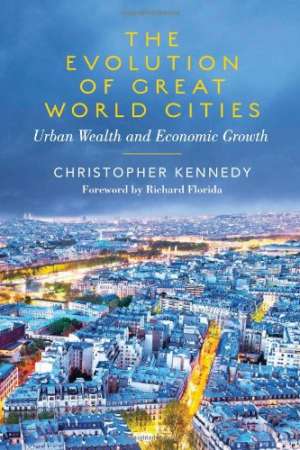03 July 2012
The Evolution of Great World Cities
Christopher Kennedy
2011, Rotman, 224 pages, £17.99
ISBN 9781442611528
Reviewer: Professor Henry Overman, London School of Economics

“Why are certain cities wealthy and how have they grown so over time?” For those of us interested in the economics of cities, this is a fundamentally important question and it is the question that lies at the heart of Kennedy’s book on urban wealth and economic growth. His attempt to answer it comes in two parts considering, “First, how cities evolve to become financial centres - and thus wealthy cities - and, second, how economic growth […] occurs in cities in general.” (p 4)
While all of this sounds fascinating, what follows, I am afraid, makes for a fairly frustrating read. After an introductory chapter, the book starts by developing a theory of urban wealth that suggests that, “The wealth of a city can be measured by the sum of such market-based assets owned by citizens.” (p54) The subtlety here arises from the focus on ‘market-based’ assets. This raises the obvious objection - what about the value of public infrastructure. Shouldn’t the London Underground be counted as part of the wealth of London? Often, however, the value of these public goods get ‘capitalised’ in the value of land and thus captured by market-based assets. Urban economists associate this insight with the famous Henry George Theorem (in turn, often associated, with arguments in favour of land-value taxation). Kennedy, somewhat surprisingly, fails to draw the parallel. (As an aside, I should note that complete capitalisation into land values requires some pretty strong assumptions.) Fortunately, none of this matters very much for the matter at hand because Kennedy only makes the most general use of this value theory in what follows.
Of course, the problem with using the value of market-based assets to talk about urban value is that the prices of these assets can be subject to fairly large fluctuations. Kennedy considers this problem in Chapter 3 with a potted history of real-estate and financial-asset booms and busts. Clearly we should ignore these short-term price fluctuations when thinking about the long-term value of assets (and hence urban wealth). Less clear, at least to this reader, is Kennedy’s assertion that we should ignore these fluctuations because transfers between asset classes mean that total wealth is conserved over the business cycle. Recent historical experience would challenge this assertion.
Indeed, Chapters 2 and 3 present little more than a distraction given the fact that Kennedy makes little use of asset-based measures of city wealth in what follows. Chapter 4 is more central and is concerned with why particular cities rise to be leading financial centres. Kennedy draws heavily on Gras’ historical theory that cities grow through four phases - as centres for commerce, industry, transport and then finance. As Kennedy acknowledges many cities don’t move much beyond the second of these phases. Kennedy asserts that what is missing when this happens is significant investment in transport. But the observation of a correlation between transport investment and financial activities is hardly proof of causation. Indeed, one can surely think of many examples where large transport investments did not lead to the development of a financial centre. In short, even if transport is a necessary condition for hosting a financial centre it is certainly not sufficient, so we are left with the puzzle of why specific places become financial centres and not others. Transport might be a piece of the puzzle, but it doesn’t appear to be the whole picture.
Chapters 5 and 6 turn to general theories of urban growth. Kennedy’s central argument here revolves around the fact that mainstream economics is wrong to put production at centre stage of stories about urban growth. Instead, he argues that consumption should occupy that position. Indeed, he claims, that “autonomous consumption associated with urban form largely explains historical growth in per capita [city output].” (p125) The ‘autonomous consumption’ he refers to is that of Keynes and reflects the spending that communities must undertake to meet basic needs. ‘Urban form’ refers to the physical characteristics, particularly as regards transport infrastructure. This is, of course, a truly incredible claim and one that deserves careful documentation and analysis. Unfortunately, however, Kennedy fails to provide this despite the fact that at the beginning of the book we are told that his central thesis is that, “Physical infrastructure substantially underpins the wealth and economic growth of cities.”
In its extreme form this proposition suggests that the only reason why cities exist is because building transport infrastructure generates incomes, which are then spent locally on cars, housing and more infrastructure, generating a virtuous/vicious circle. This is clearly too extreme. Yet the milder version of the thesis points to a link from urban form to consumption to growth that is highly suggestive and not well considered in the mainstream urban economics literature. These issues are picked up again in Chapter 7. But the more detailed case studies discussed there do not lead to further systematic analysis. This is a missed opportunity and in the end underpins my sense of frustration with the book.
